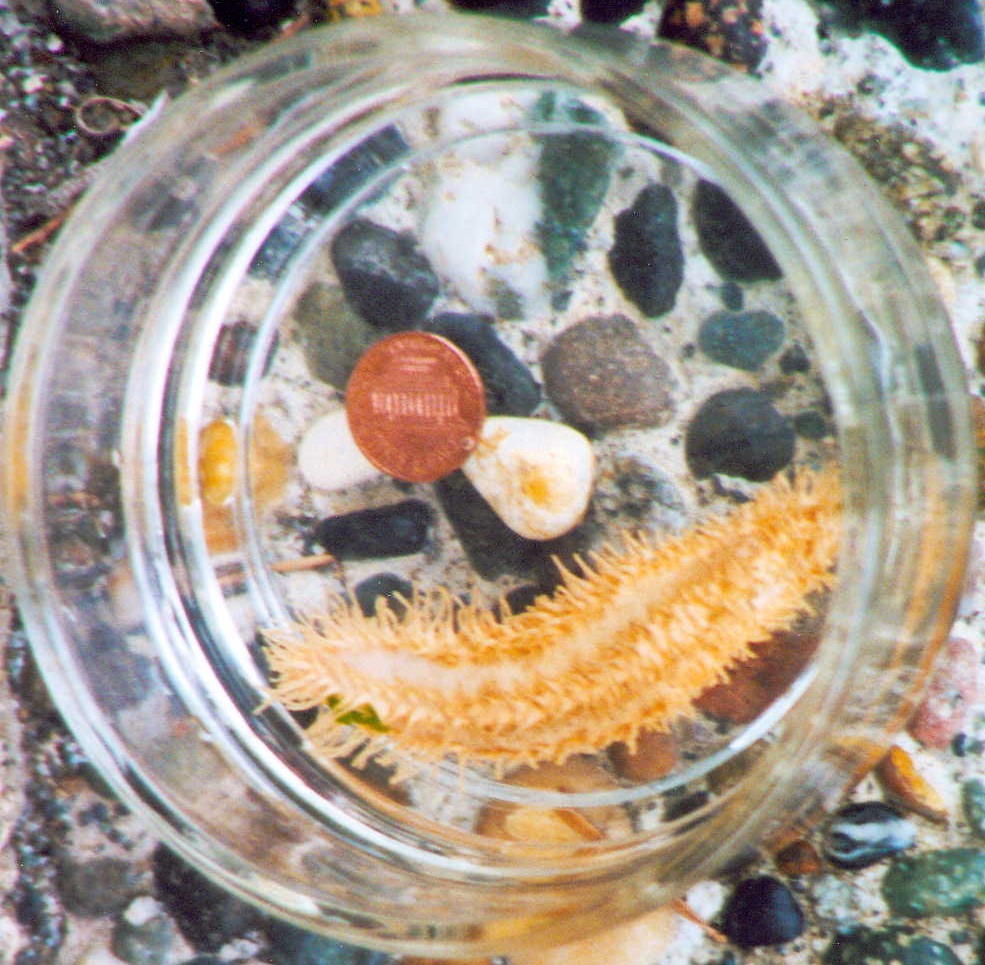Eupentacta quinquesemita (Selenka, 1867)Common names: Stiff-footed sea cucumber, white sea cucumber |
|
| Synonyms: None |  |
| Phylum Echinodermata
Class Holothuroidea Order Dendrochirotida Family Sclerodactylidae |
|
| Found in Rosario Bay, WA. Side view. Animal is approx. 8cm in length. | |
| Photo by: Kelly Williams, June 2002 | |
How to Distinguish from Similar Species: Looks almost identical to E. pseudoquinquesemita. The subtle differences are that E. pseudoquinquesemita has finer and more abundant tube feet with a broad space between the ambulacra. Its body is also softer (less rigid support from calcareous elements). E. pseudoquinquesemita has the large, oval ossicles in the skin but lacks the smaller, basket-shaped ossicles found in E. quinquesemita. E. quinquesemita is more abundant in British Columbia (and south?) while E. pseudoquinquesemita is more abundant in Alaska. If the cucumber is buried and only the white oral tentacles are exposed, it could be confused with Cucumaria pallida. However, C. pallida has 10 oral tentacles of approximately equal length while E. quinquesemita has 8 long and 2 short.
Geographical Range: Sitka, Alaska to Baja California; Japan
Depth Range: Low intertidal to 55 m
Habitat: Under and between rocks and in crevices. Often found in areas of strong current.
Biology/Natural
History: E. quinquesemita
is eaten by the sea stars Solaster
stimpsoni, Pycnopodia
helianthoides, and Dermasterias
imbricata, and juvenile Eupentacta
are a staple food for
Leptasterias
hexactis. Adults rarely expose their
tentacles during daylight
hours. Typically have bits of shell and other materials
attached
here and there to the tube
feet. Spawning occurs in the spring (March to
May). Development
is indirect. Eggs, embryos, and larvae are greenish in
color.
The body wall is poisonous to at least some fish. This
species eviscerates
seasonally in the fall. Thyonicola americana
is a shell-less
snail that parasitizes the gut.
| Return to: | |||
| Main Page | Alphabetic Index | Systematic Index | Glossary |
References:
Dichotomous Keys:
Kozloff, 1987
Carlton, 2007
General References:
Harbo,
2011
Lamb
and Hanby, 2005
Lambert,
1997
Morris,
Abbott, and Haderlie, 1982.
O'Clair
and O'Clair, 1998
Ricketts
et al., 1985
Sept,
1999.
Scientific Articles:
Byrne, M., 1998. Ultrastructure of autotomy and catch
connective
tissue regions of the integument of Eupentacta quinquesemita
(Holothuroidea).
p 447 in Rich Mooi and Malcolm Telford (eds), Echinderms: San
Francisco.
Proceedings of the ninth international Echinoderm Conference San
Francisco,
California, USA 5- August 1996. A.A. Balkema
Emlet, Richard B., 1994. Body forms and patterns of ciliation in nonfeeding larvae of echinoderms: functional solutions to swimming in the plankton? American Zoologist 34: pp. 570-585
General Notes and Observations: Locations, abundances, unusual behaviors, etc.:
Authors and Editors of Page:
Kelly Williams (2002): Created original page
Edited by Hans Helmstetler 12-2002; Dave Cowles 2013-